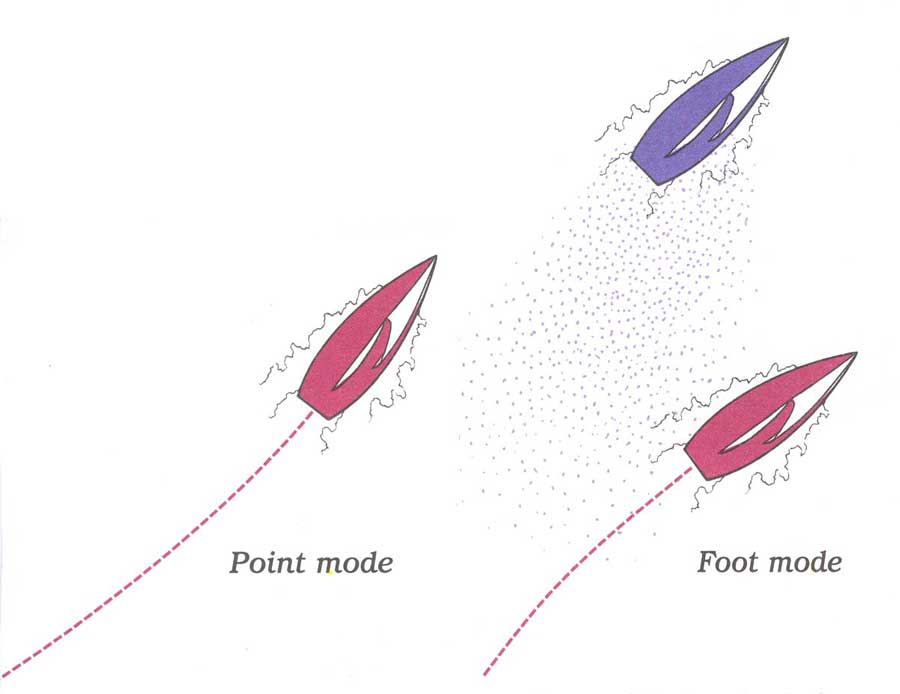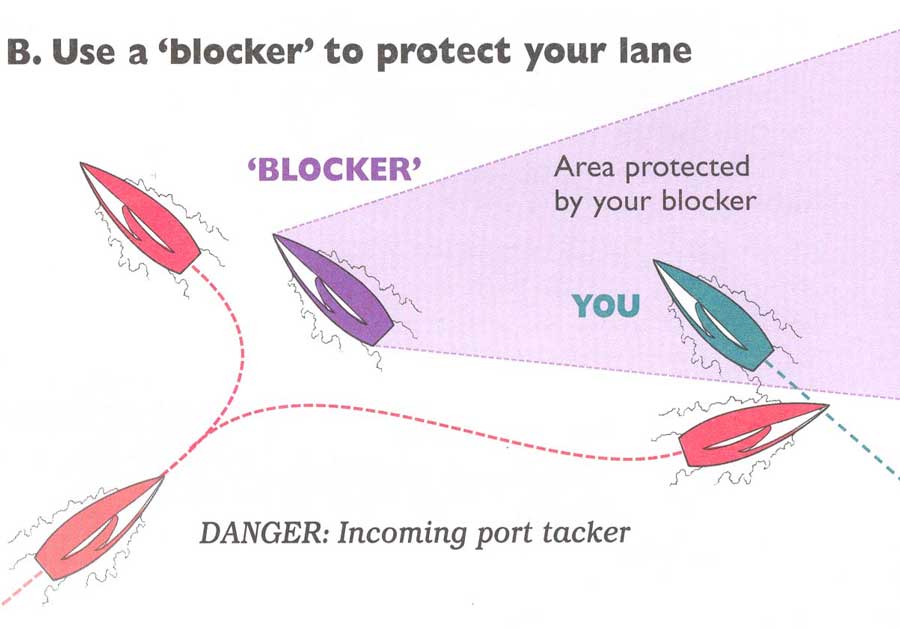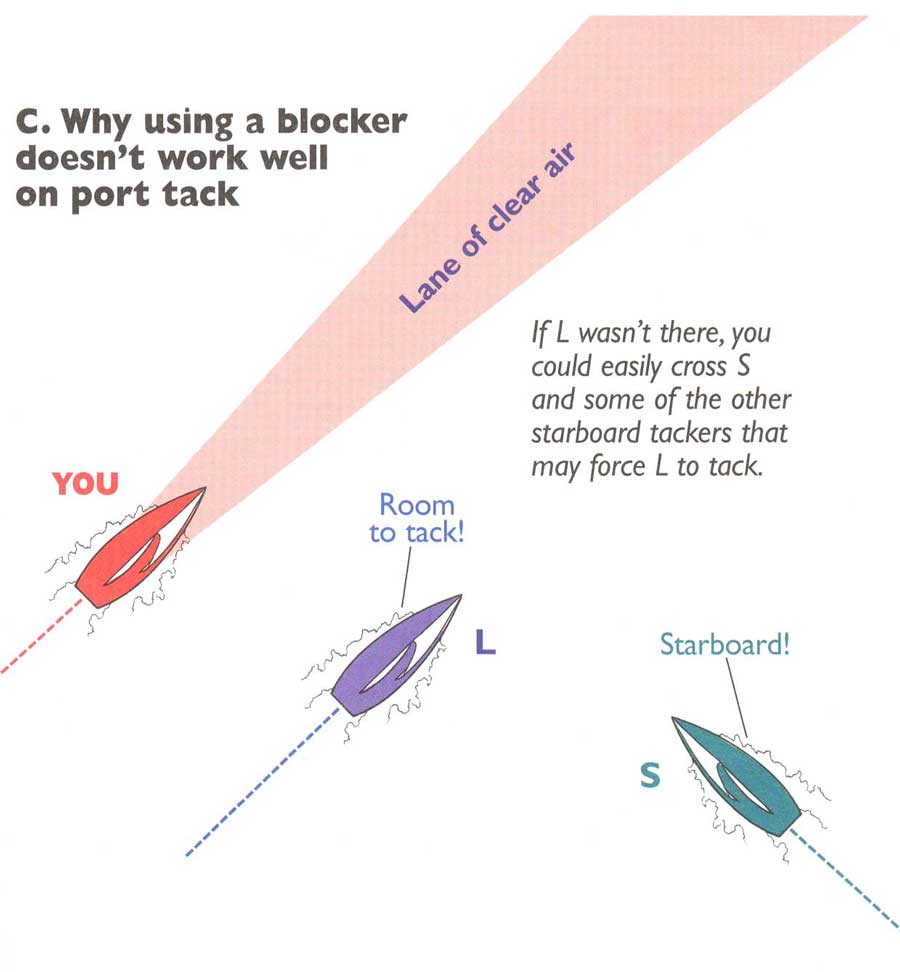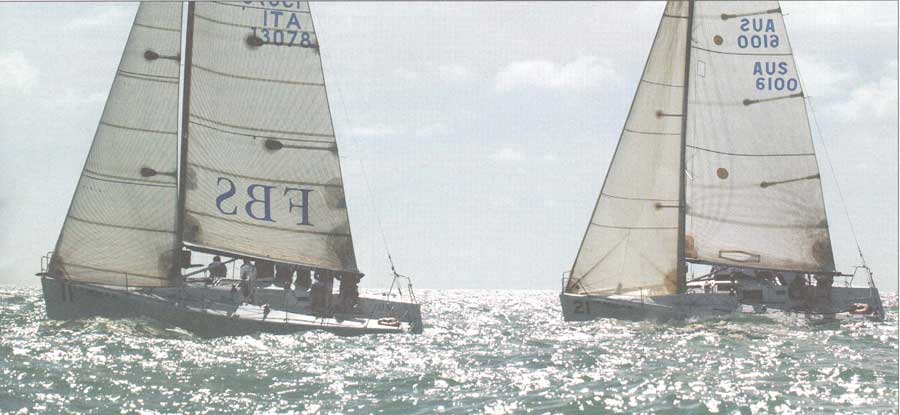Avoid Bad Air from Other Boats
by David Dellenbaugh
When it comes to other boats, your biggest tactical problem is usually the wind shadows they create. While it’s true that you sometimes have to change your course to avoid hitting your competitors or to give them right of way, these problems are generally not as significant as the widespread effects of bad air.
In a big fleet it’s not uncommon to sail in disturbed air for at least part
of each upwind leg, especially the first one where boats are usually bunched
quite close together. But whenever you are affected by another boat’s wind
shadow, you can be sure that you are going slower than, and losing ground
to, many other boats in the fleet.
The existence of wind shadows on a beat is one obvious reason why the
leaders of a fleet keep getting farther ahead and the tail enders get
further behind. So one of your main tactical challenges on any beat is
figuring out how to keep your air clear as long as possible. Here are some
ideas on how to do this:
| A. When somebody tacks on your wind If you want to stay on the same tack, you have two basic options for keeping your air clear of a boat in front of you. If you choose foot mode, you can often find clear air to leeward of that boat even when your bow is behind theirs. |
 |
| Pinch up above bad air By shifting into ‘point mode,’ you can often keep your air clear to windward of a boat that tacks in front of you. You won’t be able to maintain this height for long, however, so choose this option only when you have a short way to go on this tack (e.g. you’re almost to the layline). Foot off below bad air |
• Know the location of bad air.
If you want to avoid wind shadows, you must know where they are. Remember
that dirty air extends to leeward of a boat in the direction opposite to her
apparent wind.
 |
| Set up above another starboard tacker On starboard tack, one of the biggest threats to your lane of clear air is a port tacker that can’t cross you. If they tack on your lee bow, their bad air will force you to tack and look for a new lane of clear air. Prevent this by setting up several boatlengths to windward of, and roughly on the same ladder rung as, another starboard tacker (see diagram and photo). This boat is now your ‘blocker’ and will deflect incoming port tackers away from your lee bow. Boats on port tack that would have been in a position to lee-bow you will now have only two other choices - either lee-bow your blocker, or bear off behind your blocker and duck you as well. |
• How bad is bad air?
Your tactics should take into account the relative importance of avoiding
bad air. For example, in light wind it is usually very slow to sit in
another boat’s wind shadow. When someone tacks on your breeze, you must
almost always do something to clear your air, even if this means putting
your strategic plan on hold for a minute. But in heavy air, bad air is much
less harmful, so you might decide to keep sailing in a boat’s dirty air.
 |
• How valuable is clear air?
Your tactical plan should also reflect the ease or difficulty of finding
clear air. When you’re racing in a large fleet, it can be very difficult to
avoid other boat’s dirty air, especially on the first beat. Therefore, it
might be worth doing almost anything to find your own lane of clear air -
even sailing toward the unfavored side of the course!
In a small fleet, however, clear air is easy to find. So make sure that you
are in clear air almost all the time, and don’t be willing to give up very
much (e.g. sail in the wrong direction) in order to find clear air.
 |
| One of the best ways to protect your lane on starboard tack is by
using another starboard tacker as a ‘blocker.’ You have to be far enough
away from the leeward boat so she will not be hurting you, but close
enough that she will deflect any incoming port-tackers who might lee-bow
you. Photo by JH Peterson |
• Steer clear of your competitors.
When you’re trying to sail fast with clear air, it’s almost always better to
keep away from other boats if possible. Every boat leaves behind an area of
disturbed wind and water that will make you go slower. It’s not always easy
to avoid this, but here are some things to try:
• Look to windward and ahead for “lanes” or “zones” of clear air. Try to
anticipate how you can position yourself in these areas of fewer boats where
you will have a better chance of avoiding bad air.
• Sometimes you must be willing to compromise a bit on your strategic
plan in order to keep sailing fast.
• Don’t make a habit of tacking on other boats, and they will tend to
leave you alone as well.
• Avoid putting yourself in positions (e.g. on the layline) where boats
ahead of you are likely to tack.
• Wave a port tacker across. When you’re in a good lane on starboard
tack, it’s better to duck a port tacker than to have her lee-bow you.
• Use other boats to help you.
There are a few times when the presence of other boats can actually help you
maintain clear air.
• When you’re on starboard tack, use a ‘blocker’ on your leeward side to
keep port tackers from tacking on your lee bow (see Diagram B).
• When you’re in a good lane on port tack and you’re almost crossing a
starboard tacker, ask them if you can cross. This is often a better way to
keep clear air than tacking or making a big duck.
• Put yourself in a ‘safe leeward’ position on other boats. You’ll get a
lift and more pressure as the wind bends around the front of their sailplan.
Dave publishes the newsletter Speed & Smarts. For a subscription call:
800-356-2200 or go to:
www.speedandsmarts.com
All contents are copyright (c) 2007 by
Northern Breezes, Inc. All information contained within is deemed reliable
but carries no guarantees. Reproduction of any part or whole of this
publication in any form by mechanical or electronic means, including
information retrieval is prohibited except by consent of the publisher.